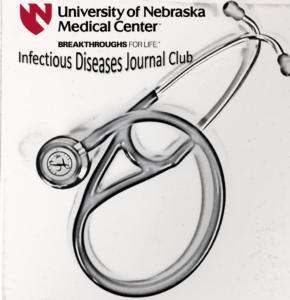Stewardship in Community Hospitals: How should we spend our limited resources?
 The following is a review by our ID Fellowship Program Director Dr. Trevor Van Schooneveld from our last Infection Control/Antimicrobial Stewardship Journal Club. He discussed the article by Anderson et al: Feasibility of Core Antimicrobial Stewardship Interventions in Community Hospitals. JAMA Network Open. 2019;2(8):e199369.
The following is a review by our ID Fellowship Program Director Dr. Trevor Van Schooneveld from our last Infection Control/Antimicrobial Stewardship Journal Club. He discussed the article by Anderson et al: Feasibility of Core Antimicrobial Stewardship Interventions in Community Hospitals. JAMA Network Open. 2019;2(8):e199369.
Antimicrobial stewardship is important to improving patient care and outcomes and numerous entities recommend that hospitals implement an Antimicrobial Stewardship Program (ASP). Joint Commission requires ASPs in all settings and CMS is considering requiring all acute care facilities to have ASP. While ASP are common at large medical centers, smaller facilities including both community hospitals (CH) and critical access hospitals (CAH) are much less likely to have an active ASP. Additionally, the utility of strategies commonly employed in large facilities such as pre-authorization of antimicrobials (PA) and post-prescription review of antimicrobials (PPR) have not been evaluated in these smaller facilities who often lack ID trained personnel to support their program.
Anderson and colleagues set out to evaluate the feasibility and impact of implementing these two common strategies (PA and PPR) in four community hospitals. They enrolled 4 moderately sized CH (median 305 beds) who did not previously have an ASP and trained at least one pharmacist at each location in appropriate antibiotic use and conflict resolution. They implemented PA at 2 facilities and PPR at the other 2 for 6 months with both strategies focusing only on use of vancomycin, piperacillin/tazobactam (PT), and carbapenems. There was then a one month washout period followed by implementation of the alternative strategy. The local pharmacists has their stewardship time financially supported by the study site and received bimonthly feedback from the study center which has regional expertise in stewardship. Clinical guidelines were available to assist evaluation of antibiotic appropriateness. Local ID clinicians were only available routinely at one site and were not involved the ASP.
The primary outcome was to determine if ASP implementation was feasible which it was in each facility. Although it should be noted that strict PA where an antibiotic is not distributed until approved was not feasible at any site and a modified PA was implemented where the first dose was distributed and then the appropriateness reviewed by local pharmacists. Both pharmacists and physicians were somewhat skeptical about the improvement to patient care in post-implementation surveys. While nearly 50% of clinicians said they didn’t make any changes to antibiotics based on pharmacist recommendations over 30% admitted to choosing a non-study antibiotic to avoid a pharmacist call. The intervention was limited in scope as it only captured 30% of all study drug prescriptions. There were significant differences in the PA and PPR group with more antibiotics judged “appropriate” in the PA group and fewer interventions. The PPR group judged 41% of all study antibiotics inappropriate and intervened much more frequently, often with recommendations to de-escalate. Study antibiotic use did not significantly change although this was likely confounded by a PT shortage and increases in vancomycin use at all facilities the authors hypothesized was due to the introduction of the SEP-1 quality measures. Overall antibiotic use did not decrease during the PA portion but declined significantly with PPR. It should be noted that while statistically significant the decline represented a 5% decrease in use.
What lessons can we take from this study?
- Antibiotic use in CH is as high as many large facilities and there is a great opportunity to improve antibiotic use in these facilities.
- Implementation of stewardship strategies is feasible in CH but the mechanisms used in this study did not generate major improvements in antibiotic use.
- Pre-authorization seemed to be less effective in CH. This may be due to lack of empowerment of local pharmacists, early diagnostic and clinical uncertainty, or lack of ID involvement in PA support. Better support for PA, particularly from ID experts, should be present if it is to be employed.
- PPR, while showing some utility, could be improved in its effectiveness. Nearly 70% of study medications had no intervention likely due to availability factors with a single trained pharmacist at most sites, only operating during business days, and targeting PPR to 72 hours post-prescription when the median LOS was only 2 days.
- In review of individual facility data some facilities were successful at decreasing antibiotic use while others saw only small decreases or even increases. This is likely due to local factors which may include pharmacist comfort with interventions, pharmacist communication effectiveness, clinician willingness to accept advice, and institutional prescribing culture.
- It is likely that team-based stewardship activities supported by ID experts may be more successful. The local pharmacists received feedback from the study site but it is unclear how instructive and supportive this feedback was. Additionally, it does not appear a local stewardship team was develop. Multidisciplinary involvement with strong support from local leadership is essential to successful ASP development and implementation.
 The authors of this study should be complimented for both addressing an oft neglected areas of ASP implementation (smaller facilities) and attempting to delineate which primary stewardship strategy is most effective in these settings. For those who participate in ASP in CH and CAH this study provides much to learn from.
The authors of this study should be complimented for both addressing an oft neglected areas of ASP implementation (smaller facilities) and attempting to delineate which primary stewardship strategy is most effective in these settings. For those who participate in ASP in CH and CAH this study provides much to learn from.
Anderson DJ, Watson S, Moehring RW, et al. Feasibility of Core Antimicrobial Stewardship Interventions in Community Hospitals. JAMA Network Open. 2019;2(8):e199369. https://jamanetwork.com/journals/jamanetworkopen/fullarticle/2748048